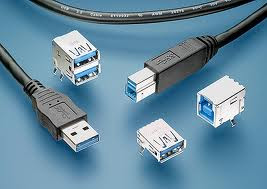Super Speed with USB 3.0
 USB connection technology continues to evolve for the better by offering speeds doubled since their introduced in 1996. When the USB 2.0 system was no longer able to meet the demands of an increasingly high data flow, counterposed the successor standard that is now known as USB 3.0.
USB connection technology continues to evolve for the better by offering speeds doubled since their introduced in 1996. When the USB 2.0 system was no longer able to meet the demands of an increasingly high data flow, counterposed the successor standard that is now known as USB 3.0.
If previously known as USB 2.0 "High-Speed USB", USB 3.0 now comes with the term "SuperSpeed". This means, the technology is faster than previous generations. At the USB 2.0 technology, the maximum data transfer speeds that can be reached at 480 Mbps (meg abits per second) or about 60 MB/sec. At this rate initially to be sufficient to meet the needs of data traffic at the time. But as the height needs greater bandwidth of data (such as the HDTV), USB 2.0 to appear sluggish.
abits per second) or about 60 MB/sec. At this rate initially to be sufficient to meet the needs of data traffic at the time. But as the height needs greater bandwidth of data (such as the HDTV), USB 2.0 to appear sluggish.
Further improvement to produce a standard USB 3.0. This standard has a speed of 3200 Mbps (3.2 Gbps) (with theoretical speeds of 4.8 Gbps/600 MB/sec). This value is 10x faster than USB 2.0. To achieve a significant increase in data transfer, the system read and write to a USB 3.0 2-way made simultaneously (bi-directional), something which can not be done by USB 2.0 technology.
Port USB 3.0 type A (above) are still similar to the old USB but with blue color code and type B (middle) and Micro-B (bottom) with a slightly different shape with the previous socket.
Although a newcomer, the USB 3.0 standard still allows access to USB 2.0 devices through a new port (backward compatible). But of course the performance of USB 2.0 devices will not increase significantly utilize USB 3.0 this path. Our experience proves that the performance of USB 2.0 devices in USB 3.0 port can go up to around 5-10%. Remember, the physical form will be the same USB 3.0 port with USB 2.0 (type A port.) However, there are 4 extra cable channels so that the USB 3.0 cable channels total up to 9.
In addition to the advantage of better speed USB 3.0 was also still save a little short. Some of them are cable length limitations of only 3 meters maximum (ideal). This is different to the length of the USB 2.0 technology, which allows a maximum cable length of 5 meters. Another minus comes from the presence of a magnetic disk devices whose performance depends on the speed of the disc. However, the USB 3.0 technology has brought improvements that are expected at the center of transportation needs of the growing digital data.
The device that have been integrated USB 3.0 technology is Transcend JetFlash 700 USB 3.0 Flash Drive.

